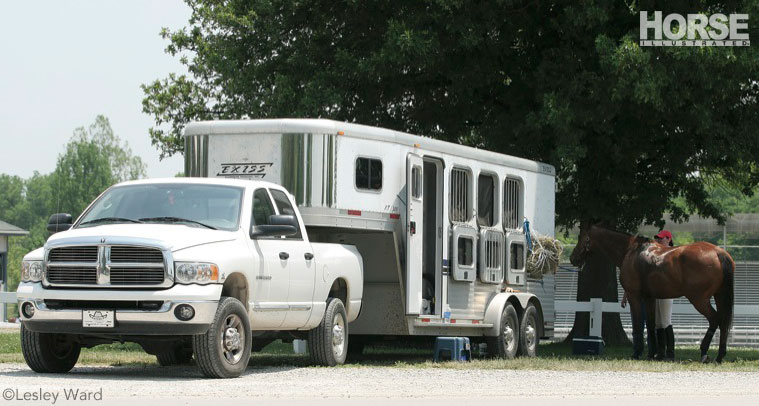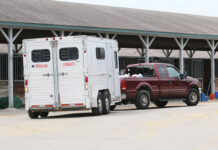
Once you’ve decided to buy a trailer, you’ll find an almost endless array of choices. How do you pick the best one, and how can you know it’s safe? Follow our experts’ advice and avoid trouble down the road.
Narrow Your Horse Trailer Choices
“Look at the owner’s manual; check the [trailer’s] gross vehicle weight and stay within that, remembering that this includes the trailer, horses and everything else you’re going to put in the trailer,” says Kevin Scott, a salesman at Nelson’s Trailer Sales & Service in Ocala, Fla. “The owner’s manual isn’t going to lie; it’s black and white what a vehicle can pull, and you need to stay within that range.”
You don’t want to push a vehicle’s towing ability to the max on a regular basis, whether you are on flat roads or towing in the mountains. If you are consistently within about 1,000 pounds of the vehicle’s maximum towing weight, you should consider stepping up to a vehicle with more towing capacity.
Interior and Exterior Trailer Materials
When it comes to materials, you have three options: aluminum, steel or a combination of the two. The two major advantages of all-aluminum trailers are that they never rust and they’re lighter in weight than all-steel trailers. For these reasons, an all-aluminum trailer will cost significantly more than an all-steel trailer of the same size and style. A steel frame with aluminum skin is a popular compromise to reduce weight while keeping the cost down.
Today’s trailers also have flooring options. While wood floors topped with rubber mats are common, you can also get a rubber material such as WERM poured in over the existing floor. Another option is Rumber. Made from 100 percent recycled tire rubber and plastics, this composite material is cut into “boards” and bolted directly to the trailer frame. Rumber doesn’t crack, rot or split; is impervious to fluids, oil and ultraviolet rays; and provides a cushioning surface.
Inspecting for Trailer Safety
Before you purchase any trailer, you should thoroughly inspect it for safety, no matter how new it is, and especially if it is used.
“The only standards for trailers in the U.S. are for axle quality, trailer wheels and tires, and these are minimal standards, so you need to do a careful inspection,” says Rebecca Gimenez, Ph.D., president of Technical Large Animal Emergency Rescue (TLAER), which has compiled a database of over 1,000 wrecks spanning 20 years. Based in Macon, Ga., TLAER provides courses around the country, teaching the intricacies of rescuing horses and other large animals from entrapments, such as trailer wrecks, ditches, barn fires, et cetera.
It’s easy to get swept up in all the bells and whistles on a fancy trailer, such as plush living quarters, but you should start by inspecting the exterior, including underneath.
“When you go to look at trailers, take a piece of plastic to lie on or a wheeled dolly so you can slide under the trailer, and bring a flashlight,” says Gimenez.
Exterior Observation
Walk around the trailer, paying close attention to the following points:
- Seams/Welds: Any place where various sections of the trailer come together should be solid with no cracks, broken welds or deep rust. On an older steel trailer, surface rust is not unusual, but any deep rust is a red flag.
- Hitch: Whatever the style of the hitch, make sure it’s well-lubricated, moves freely and works properly. Check that the receiver ball matches the size listed on the trailer’s coupler. An incorrect ball size is commonly the reason a trailer will come unhitched. “We’ve seen many horrific wrecks, but if the ball is the correct size and the trailer is hitched correctly, it will not come apart,” says Gimenez.
- Safety Brake Cable: Unless it’s an older trailer, it should have a safety brake cable designed to engage the brakes if the trailer ever comes unhitched. In order to function, the cable needs a battery, so look for this and check to see that it is in working order.
- Safety Chains: These should be heavy-duty chains with large, heavy-duty snaps. They need to be welded to the trailer, as their sole purpose is to keep your tow vehicle and trailer together long enough for you to slow down and stop if the hitch fails. Criss-cross the chains under the hitch when in use.
- Tires: “Look at the sidewalls,” says Scott. “A tire can have all the tread in the world but have dry-rot or weather-rot. Most of the time you can see this on the sidewalls, and sometimes between the treads. Also check the valve stems; if you can push on them and air comes out, they need to be replaced.” Look for the date on the tires; if they’re more than five years old, you’ll want to replace them, even if the tread is good. Older tires start to break down from the inside, where you can’t see it. If the tires are in good shape, look to see if they’ve been balanced. This will be obvious if you see the small, oblong metal weights along the rim.
“Trailer tires are usually the cheapest you can find, so with most trailers, you may be putting a $50,000 horse on a set of $70 tires,” warns Gimenez. “You may want to put better tires on it once you buy it, especially if you are hauling long distance.”
Finally, keep the recommended amount of air (PSI) in your tires. The acceptable range of PSI will be listed on the tire itself. Over- or underinflated tires will wear faster and have a higher risk of blowouts.
- Wheel Bearings: “Facing the trailer, push and pull on each tire,” says Scott. “If there is any play in it, this tells you the bearings probably need to be replaced.” Pop off the cap on each wheel that protects the bearings to see if they are lubricated. If not, the trailer has not been well-maintained, says Gimenez. A dry bearing can lock up, and even start a fire if hot enough. Have wheel bearings lubricated and repacked as necessary; this is generally done during an annual trailer servicing appointment.
- Brakes: Most trailers today have electric brakes, but just pulling the trailer won’t tell you if they are working right. “There’s no way to know if the brake assembly is in good shape and working properly unless you pull the entire wheel off,” says Scott, who recommends a professional inspection.
- Lights: You’ll need a second person to sit in the tow vehicle and operate the brakes and turn signals while you walk behind the trailer to check that the lights are working. (Note: Working lights shouldn’t be a deal-breaker when buying a used trailer, as they often go out. They are relatively easy and inexpensive to fix.)
- Reflective Tape: Is there enough to make the trailer safely visible in the dark? Most trailers don’t have enough, but you can easily remedy this by buying a roll of reflective tape at a farm supply store and applying it to the sides and rear of the trailer.
Get Underneath the Trailer
The trailer may have a pristine paint job and look fine, but you need to get underneath to take a close look at the following:
- Axles: They should be straight. Look to see that the “U” bolts holding the axles onto the frame are present and intact. (If ordering a new trailer, Gimenez strongly recommends getting heavy-duty axles.)
- Frame: If aluminum, look for broken welds or corrosion. If steel, look closely for rust and pitting. Surface rust is acceptable; what you don’t want is rust that is deep enough to damage the frame’s overall integrity.
- Wiring: This should be heavy-duty wire in conduit. You don’t want to see unprotected wires stapled or taped in place. A problem with wiring can lead to tiny electrical shorts, which your horse can feel.
- Floor: If wood, look for damage or rot by pressing a screwdriver against the wood wherever it touches the frame. These are the first places wood will start to rot and affect the integrity of the floor. Even when made of pressure-treated wood, floors should generally be replaced every 10 years, and more often if heavily used or in regions where roads are salted in winter, notes Gimenez.
Interior Trailer Components
If the trailer passes your exterior/underneath inspection, you can check out the interior.
- Doors: Keep an eye out for any rust or broken welds and observe hinges for stability. Make sure the latches close securely.
- Ramp (if present): A ramp is like a floor, says Gimenez, so it must be sturdy and made of quality material. Ideally, it should be covered with a rubber mat or textured coating to provide traction.
- Head Room: The trailer should be tall enough inside that your horse has at least 2 ½ feet above his withers to the ceiling, preferably more.
- Interior Floor: Pull up any mats and look closely at the frame and floor. Moisture can cause aluminum to pit and corrode, or steel to rust.
- Bulkhead: Check the welds/seams where it attaches to the frame. Some bulkheads have saddle racks and bridle hooks, but Gimenez dislikes having anything here because a horse could be thrown into this area if you get in a wreck. You wouldn’t want him to survive an accident only to impale himself on your saddle rack.
- Roof: Drip lines on the interior walls can indicate a roof leak, Scott says. (If at all possible, park your trailer under cover when not in use.) Are there adequate roof vents to provide airflow? What is the material? Many people like fiberglass because it makes the interior lighter and cooler than an aluminum roof, but Gimenez is not a fan. “Fiberglass fails horrifically in a wreck,” she warns.
- Ventilation: Trailer interiors can really heat up, especially with horses’ body heat. While you can add ventilation to any steel or aluminum trailer, this will increase the cost, so look at what’s already in place. Are there roof vents? Do the windows slide open and/or drop down? (Safety note: Never haul horses with windows open so that they can put their heads outside the trailer—this is extremely dangerous. Window bars should only be dropped when the trailer is parked.)
- Walls: They should be smooth and free of anything a horse can injure himself on. You can always add mats. Vinyl or leather “lean” pads offer extra comfort.
- Chest/Butt Bars: These should be sturdy, easy to operate and thickly padded or wrapped for protection and comfort.
“If the trailer has passed all of these inspections, then you can look at the living quarters and tack compartment and see if they work for you,” says Gimenez.
“Your best bet is to buy from a dealer because even if you’re buying a used trailer, they will have inspected it and fixed anything that needs attention,” says Scott. “If you’re buying a used trailer privately, have it inspected by a reputable shop before you purchase it.”
Trailer manufacturers don’t perform crash tests, so there’s no simple way to do safety comparisons between makes and models. This means it’s up to you to carefully inspect and purchase the safest trailer you can afford, and then do everything possible to keep it well-maintained. After all, it’s designed to haul priceless cargo.
Liked this article? Here’s more on safe trailering:
Find the Right Trailer
Video: Inspecting a Horse Trailer
Horse Trailering Guide
CYNTHIA McFARLAND is an Ocala, Florida-based freelance writer and horse owner. The author of eight books, her latest is Cow-Horse Confidence: A Time-Honored Approach to Stockmanship, co-authored with Martin Black.
This article originally appeared in the October 2013 issue of Horse Illustrated magazine. Click here to subscribe!







good advice
yes good article
great tips
Good to keep in mind.
Great tips but how on earth could you give 2.5 feet of clearance over the withers? My horse is small in the hunter jumper world at 16 h. That’s 5’4″ plus 2’6″ would put us at almost 8 feet! I’ve not seen anything over 7’6″ that can be pulled by a truck. Semis are taller of course.
Thank you for explaining that your trailer should have at least 2 1/2 feet above his withers to the ceiling. My sister is looking to buy a horse trailer, but has been wondering what she should look for before looking at some potential options. I’ll share this with her so that she can more accurately determine the measurements that she’ll need for her trailer.